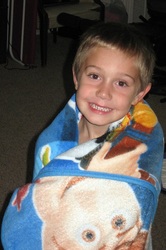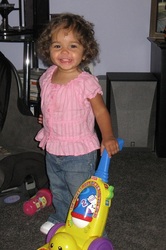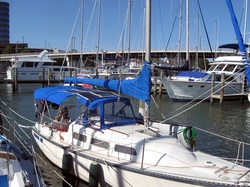
Orion Jr all decked out and ready to go
We spent the first 2 weeks of October making the final preparations for our departure for points south. Given the late start on the canvas project, Cathy was barely coming up for air, while Dave’s projects were mostly done, leaving him time to start some of the provisioning, stowing and organizing on the little boat. At this point, we’ve made our final trips to see the kids and grandkids, turned in the car and are about as ready as we’re going to get.
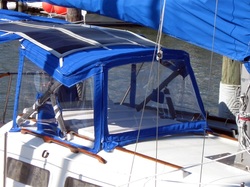
Completed “dodger”
Closing In
Cathy spent almost all of her waking hours during the first half of October working on the 3 panels that would enclose the companionway. This is traditionally called a dodger, but our enclosure was breaking a few of the rules that would make this an official dodger, which usually has 2 bows, with the longest of the 2 leaning aft. Ours had only one, which naturally leaned forward. This difference meant that most instruction manuals about how to build a dodger were not that helpful. Instead, Cathy relied on studying the panels Pat had made for Orion and copious advice from both Pat and Jo.
The first panel to be made was the center one or windshield. The biggest challenge in constructing this panel was spanning the large sliding hatch, which needs to move back and forth right where you would normally want to secure the panel to the deck. Without any deck fitting across the 4ft expanse, the panel was at risk of sagging or bending so the clear vinyl (i.e. Strataglass or just “glass”) would not be flat and visibility would be poor. To ensure the glass stayed as flat as possible, Cathy installed a 2” wide batten that we trimmed to about 4 feet in lengt to fit a
pocket that she put into the panel’s base. The panel was then attached by zipper to the canvas roof and the 2 yet-to-be-built side panels, and with 2 twist-lock fittings screwed into the deck on each bottom corner. Constructing this panel without a proper sewing table to work on was a bit challenging, since it required working with the large pieces of glass with limited flat space, while preventing any scratches that would affect our ability to see through the finished product.
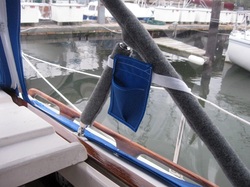
One of several new cockpit pockets
But Cathy managed to finish it, and from a distance it doesn’t look too bad. She quickly moved onto the 1st of the 2 side panels, using the lessons learned from the windshield to make this a simpler construction. Then the 3rd panel was virtually a mirror image of the 2nd, making it even easier to finish (applying still more lessons learned). Once all 3 panels were in place, Cathy used boat blanket material to make sleeves for the part of the bows that touched the glass. This prevents the hot metal from “burning” the glass and has the added advantage of giving us a surface to hang pockets in the cockpit. Almost exactly 2 weeks from starting the first panel, the 3 panels were installed and protecting the cabin top as the first of several days of rain arrived. The cabin stayed dry with the hatch open, as designed. But there was little time to sit back and admire this accomplishment, since there’s was still plenty more to do.
Cathy next turned her sewing machine to the construction of several cockpit pockets that would hold the detritus that we need in the cockpit while underway -- horn, binoculars, log book, water bottles, SPOT tracker, guide books, etc. Using Sunbrella, Phifertex (a mesh material), some webbing and sew-on hook and Loop (aka Velcro), she constructed four of these pockets of various sizes and mounted them on the bows and the stern rail. Before stowing the sewing machine for the duration, she also added a zipper to the sail cover to keep the mainsail off the bimini and solar panels and created a few boat blanket sleeves for Steve’s boat as well. That should hold us for now. It’s time to put the sewing machine away.
Cathy next turned her sewing machine to the construction of several cockpit pockets that would hold the detritus that we need in the cockpit while underway -- horn, binoculars, log book, water bottles, SPOT tracker, guide books, etc. Using Sunbrella, Phifertex (a mesh material), some webbing and sew-on hook and Loop (aka Velcro), she constructed four of these pockets of various sizes and mounted them on the bows and the stern rail. Before stowing the sewing machine for the duration, she also added a zipper to the sail cover to keep the mainsail off the bimini and solar panels and created a few boat blanket sleeves for Steve’s boat as well. That should hold us for now. It’s time to put the sewing machine away.
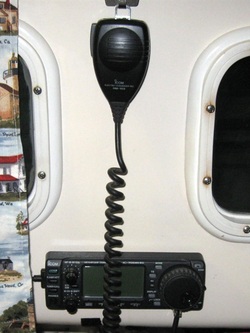
Staying In Touch
While Cathy busied herself with the sewing, Dave found other things to do. He decided to move the Ham radio from Orion over to the little boat. This is important in keeping a 3rd party aware of our movements via the Waterway Net, especially when we have trouble with our cell phone reception. Installing the radio required some more cable and copper flashing, which then allowed Dave to temporarily hook up the radio to test different configurations and possible mounting locations. Once he was successful in talking to other radio operators in distant locations, such as Miami, he felt confident to make the installation permanent. The antenna tuner was mounted in the starboard locker under the cockpit, with the radio itself mounted in the Main Saloon behind the settee. The mike and controls found a spot between the starboard portlights in the Main Saloon. The combination worked well. Dave was able to check in on the Waterway Net and could hear Fred check-in from Connecticut. Not bad for a small boat.
Our other radio, the VHF, is used for routine communication with bridges, marinas, other boats, etc. while underway. We had installed a new Standard Horizon model on the boat before leaving Mayo. However, unlike Orion, we didn’t have a remote mike. We had debated whether this was necessary, given how much smaller Orion Jr was, but with the radio below and the outboard making more noise in the cockpit, it was difficult to hear sometimes, and even harder to talk and man the tiller. Our Standard Horizon radio model was compatible with a remote mike, which Dave purchased as a birthday present for Cathy, since she was the one most concerned about access to the radio while at the tiller alone, especially when docking. The mike was easy to install on the transom, with a relatively simple run back to connect to the radio in the Main Saloon.
No problem staying in touch now.
While Cathy busied herself with the sewing, Dave found other things to do. He decided to move the Ham radio from Orion over to the little boat. This is important in keeping a 3rd party aware of our movements via the Waterway Net, especially when we have trouble with our cell phone reception. Installing the radio required some more cable and copper flashing, which then allowed Dave to temporarily hook up the radio to test different configurations and possible mounting locations. Once he was successful in talking to other radio operators in distant locations, such as Miami, he felt confident to make the installation permanent. The antenna tuner was mounted in the starboard locker under the cockpit, with the radio itself mounted in the Main Saloon behind the settee. The mike and controls found a spot between the starboard portlights in the Main Saloon. The combination worked well. Dave was able to check in on the Waterway Net and could hear Fred check-in from Connecticut. Not bad for a small boat.
Our other radio, the VHF, is used for routine communication with bridges, marinas, other boats, etc. while underway. We had installed a new Standard Horizon model on the boat before leaving Mayo. However, unlike Orion, we didn’t have a remote mike. We had debated whether this was necessary, given how much smaller Orion Jr was, but with the radio below and the outboard making more noise in the cockpit, it was difficult to hear sometimes, and even harder to talk and man the tiller. Our Standard Horizon radio model was compatible with a remote mike, which Dave purchased as a birthday present for Cathy, since she was the one most concerned about access to the radio while at the tiller alone, especially when docking. The mike was easy to install on the transom, with a relatively simple run back to connect to the radio in the Main Saloon.
No problem staying in touch now.
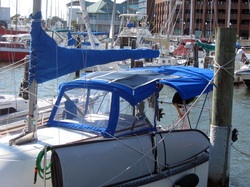
Portabote in place on Orion Jr
Small Boat gets a not so Small Boat
During the hurricane, we had taken our Portabote dinghy off Orion and stored it at Steve’s, where it remained for another six weeks, in case another storm arrived. However, as our departure date neared, we needed to get the dinghy back and mounted on Orion Jr. We were a little overwhelmed when the 12 ft boat had to be stowed on deck. We wanted to put it along the lifelines on the port side, but since it didn’t follow the curve of the deck, it took a couple of tries before we found a way to stow it out of the way of the anchor and the deck washdown pump. We finally found a location that worked, but it doesn’t look like we’ll be using the port deck much while the dinghy is on board.
The other parts of the dnghy (transom and 3 dinghy seats) had to be stowed as well. Two of the seats would fit in the port locker up under the cockpit coaming, a space we couldn’t otherwise use. So, Dave epoxied some clips to the hull that he then used to strap the 2 larger seats in place. The transom and the other seat found a spot under the companionway stairs. Finally, we had to bring the Mercury outboard over from Orion, but that fit nicely on the port stern rail, in essentially the same location it had sat on Orion. Amazingly enough, everything fit.
Who knew this little boat had so much space? Now we have 2 boats in one.
During the hurricane, we had taken our Portabote dinghy off Orion and stored it at Steve’s, where it remained for another six weeks, in case another storm arrived. However, as our departure date neared, we needed to get the dinghy back and mounted on Orion Jr. We were a little overwhelmed when the 12 ft boat had to be stowed on deck. We wanted to put it along the lifelines on the port side, but since it didn’t follow the curve of the deck, it took a couple of tries before we found a way to stow it out of the way of the anchor and the deck washdown pump. We finally found a location that worked, but it doesn’t look like we’ll be using the port deck much while the dinghy is on board.
The other parts of the dnghy (transom and 3 dinghy seats) had to be stowed as well. Two of the seats would fit in the port locker up under the cockpit coaming, a space we couldn’t otherwise use. So, Dave epoxied some clips to the hull that he then used to strap the 2 larger seats in place. The transom and the other seat found a spot under the companionway stairs. Finally, we had to bring the Mercury outboard over from Orion, but that fit nicely on the port stern rail, in essentially the same location it had sat on Orion. Amazingly enough, everything fit.
Who knew this little boat had so much space? Now we have 2 boats in one.
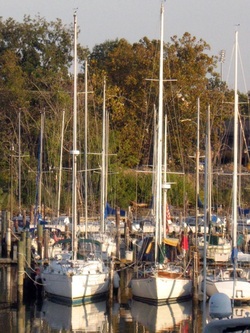
Orion sits in her slip at Joy's Marina
Goodbye Orion
Orion couldn’t be completely ignored before we left. She would be spending her first winter in the cold climate in more than 5 years. We had managed to work out a mutually agreeable arrangement with Sue to stay on board over the winter and keep an eye on her, but we still needed to winterize a number of the systems on board. So, we dusted off the notes we had taken from that first winter and started working our way through gallons of antifreeze. We started with the Air Conditioner, then did the deck washdown and swim shower. Before winterizing the engine, we topped off the fuel tank with diesel, ran it enough to warm up the engine (and lower the diesel level a little), then changed the engine oil, filter and transmission oil. After running the engine a 2nd time to circulate the new oil, Dave cleaned the raw water strainer and dumped in the antifreeze until pink liquid started spewing out the exhaust.
The only system left to winterize was the bilge pump, but Cathy first had to empty and defrost the freezer to eliminate the possibility of any water entering the bilge. This done, it was a simple matter to pump antifreeze through the bilge lines. With Sue on the boat, the fresh water system would be in use, so it didn’t need to be winterized.
Orion couldn’t be completely ignored before we left. She would be spending her first winter in the cold climate in more than 5 years. We had managed to work out a mutually agreeable arrangement with Sue to stay on board over the winter and keep an eye on her, but we still needed to winterize a number of the systems on board. So, we dusted off the notes we had taken from that first winter and started working our way through gallons of antifreeze. We started with the Air Conditioner, then did the deck washdown and swim shower. Before winterizing the engine, we topped off the fuel tank with diesel, ran it enough to warm up the engine (and lower the diesel level a little), then changed the engine oil, filter and transmission oil. After running the engine a 2nd time to circulate the new oil, Dave cleaned the raw water strainer and dumped in the antifreeze until pink liquid started spewing out the exhaust.
The only system left to winterize was the bilge pump, but Cathy first had to empty and defrost the freezer to eliminate the possibility of any water entering the bilge. This done, it was a simple matter to pump antifreeze through the bilge lines. With Sue on the boat, the fresh water system would be in use, so it didn’t need to be winterized.
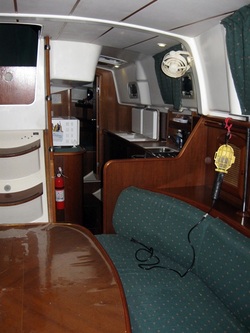
Orion all cleaned up
There were a couple of small repairs that were needed to be done before we left. Dave re-bedded the stanchion that we had repaired in May, and the pump-out fitting, both of which had minor leaks in them. Then, of course, we had been working for weeks to remove all the stuff off Orion that we had accumulated over 5 years of life aboard. Some went to Orion Jr, some to storage at Steve’s, some of it we sold (goodbye icemaker), some of it we gave away, and some it stayed behind. With all of our clutter gone, Cathy took time to do a final thorough cleaning of the boat, literally from stem to stern and top to bottom. It hasn’t looked this good since we first stepped on board.
So, with some reluctance, we turned the key in the lock for the last time this season and walked away to Orion Jr. Orion will be in good hands, but she won’t be our home again for several months.
So, with some reluctance, we turned the key in the lock for the last time this season and walked away to Orion Jr. Orion will be in good hands, but she won’t be our home again for several months.
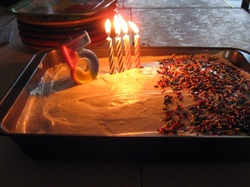
Cathy celebrates another birthday
Friends and Family
Before heading south, we made one last trip to visit the kids and grandkids and enjoyed time with both our son’s and daughter’s families. Between doing flips and somersaults and playing mock battles with superheros and getting beat at video games, we could only hope that we connected with each of the kids before leaving them for a couple of months. We celebrated Cathy’s birthday twice, which meant we got to eat 2 cakes (yum!).
Before heading south, we made one last trip to visit the kids and grandkids and enjoyed time with both our son’s and daughter’s families. Between doing flips and somersaults and playing mock battles with superheros and getting beat at video games, we could only hope that we connected with each of the kids before leaving them for a couple of months. We celebrated Cathy’s birthday twice, which meant we got to eat 2 cakes (yum!).
As the season for cruising began, we started to see more boats staying in the Hampton River or on the dock at the public piers. We were delighted to find our friends Ron and Lena on Discovery among them. They stayed for a week and we caught up and shared ideas on places for them to leave their boat for the next 9 months while they refurbish their new home in Salt Lake City. (They settled on Deltaville after driving up to visit them.)
Sue came to visit for 10 days as she made her decision to move back to Hampton. We spent some of her time familiarizing her with Orion’s systems. We re-connected with some of the local live-aboards at a dinner with John and Lisa who own a huge motor yacht in the marina. And, finally we enjoyed a farewell dinner with Steve and Krista Monday evening before heading out. Our time in Hampton had come to an end. We were to be up and underway the next morning and headed south on Orion Jr. This time we were going to the Dismal Swamp, which would be something new and we were looking forward to it.
Sue came to visit for 10 days as she made her decision to move back to Hampton. We spent some of her time familiarizing her with Orion’s systems. We re-connected with some of the local live-aboards at a dinner with John and Lisa who own a huge motor yacht in the marina. And, finally we enjoyed a farewell dinner with Steve and Krista Monday evening before heading out. Our time in Hampton had come to an end. We were to be up and underway the next morning and headed south on Orion Jr. This time we were going to the Dismal Swamp, which would be something new and we were looking forward to it.
